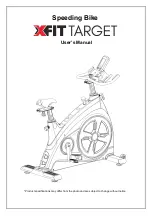
UPO2000CS series User Manua
43
Start:
Trigger at the starting moment. Namely, SDA occurs at falling edge when SCL is at logic high. Note that the restarting
state is stored in I2C, the starting signal can occur again (restart) before first signal’s stop signal. Both the start and the restart
can produce trigger signal.
Restart:
Triggers at the restarting moment. When a start signal occurs before the previous signal ends, this situation is defined
as restart signal.
Stop:
Triggers when the stop bit occurs. Namely, SDA goes from low to high when SCL is high.
Loss
:
It is the loss confirmation trigger. Every time after 8 bits are transmitted in I2C protocol, the data receiver transmits the
receiving signal, which is the answering bit in figure above. The SDA signal is low and SCL high. The loss confirmation trigger
occurs on the receiving bit, when SCL and SDA and both high.
Addr
: It is address trigger. The address trigger will occur if the communication address is the same with the user setting address.
It can help to quickly locate using address.
Data
: It is data trigger. The data trigger can occur with the following conditions: equal/greater/less/unequal. It is convenient to
analyze data and capture abnormal data.
Addr Data
:
It is address data trigger. The trigger occurs when the addresses are the same during transmitting and the data
satisfies the setting condition. It is convenient to realize the I2C specified address trigger and data trigger, and help analyze the
transmission.
Press the NEXT PAGE function key to enter additional I2C trigger settings:
Address Setting:
Press the button to set the related address information
•
Width
:
It is the address width selection. Press this option button and the address width selection list pops up. Press the
Width
function button again to select 7 or 10 bits width. Rotating the
Multipurpose
knob
can also select the width. Press the
Multipurpose
knob to confirm selection.
•
Address
: Within this interface, directly rotate the Multipurpose knob to set the address value. Note that the set value is related
to the present bit width. The seven bit address can be set from 0x0 to 0x7F and the ten bit address can be set from 0x0 to 0x3FF.
•
Direction
: Set the read-write direction. Select this option and the read/write selection list will pop up. Press the read/write
option key to switch between each other. After the selection list pops up, the Multipurpose knob can also be used. Press the
Multipurpose knob to confirm selection.
Press the
RETURN option key
to
return to the previous menu.
Data Setting:
Select this option to set the related data information
Byte:
Set the data byte. Select this option and the data byte selection list pops up. Press the button again to switch between 1,
2, 3, 4, and 5 bytes. The
Multipurpose
can also be used.
Bit
:
Select the bit. Directly rotate the
Multipurpose
knob to select the bit under the data set interface. The selected bit will be
highlighted red at the bottom left corner. Note that the selected bits are directly related to the set bytes. For example, the bit of
0 to 7 can be selected if 1 byte is set.
Data Bit
:
Set every bit of data. The present data bit can be set to H/L as required. The bottom left corner will display the
present data setting condition, and the value can be set with hexadecimal and MSB method.
All Bits
: Set the entire bit to the same value. It is helpful to quickly set the value and reset. Press the NEXT PAGE option key to
enter additional I2C trigger settings.
Data Condition
:
Use this option to set the relation between the captured and set data when data is triggering. The captured
Summary of Contents for UPO2000CS Series
Page 1: ...1 ...
Page 64: ...UPO2000CS series User Manua 63 X Y Phase Difference Table ...
Page 69: ...UPO2000CS series User Manual 68 User Defined Parameter Statistics ...
Page 92: ...UPO2000CS series User Manua 91 This user manual may be revised without prior notice ...
Page 93: ...UPO2000CS series User Manual 92 ...
Page 94: ...UPO2000CS series User Manua 1 ...
















































